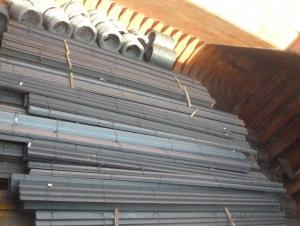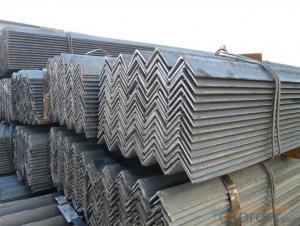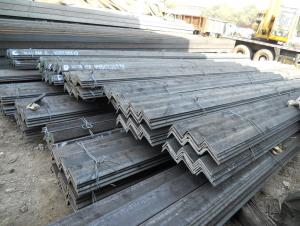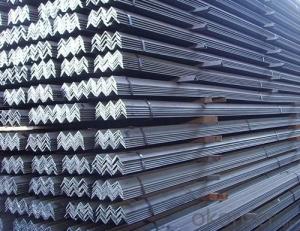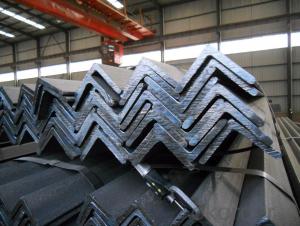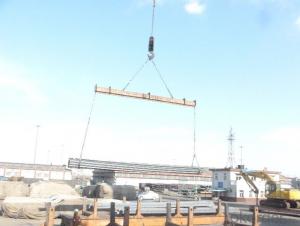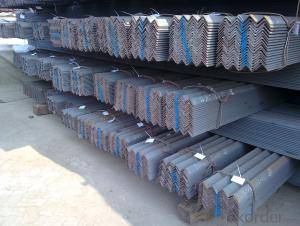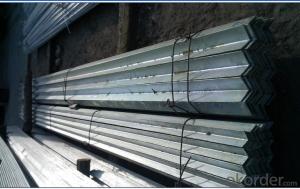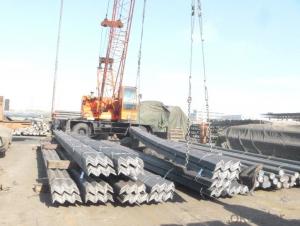GB ALLOY HOT ROLLED ANGLE STEEL 75*75 6M
- Loading Port:
- Qingdao
- Payment Terms:
- TT OR LC
- Min Order Qty:
- 50 m.t.
- Supply Capability:
- 10000 m.t./month
OKorder Service Pledge
OKorder Financial Service
You Might Also Like
Product Description:
Specifications of JIS SS400 Angle Steel
1.Standards:GB,ASTM,BS,AISI,DIN,JIS
2.Invoicing on theoretical weight or actual weight as customer request
3.Material: JIS G3192,SS400;SS540.
4. Payment terms:
1).100% irrevocable L/C at sight.
2).30% T/T prepaid and the balance against the copy of B/L.
3).30% T/T prepaid and the balance against L/C
5.Sizes:
EQUAL ANGLES SIZES |
| ||
a(mm) | a1(mm) | thickness(mm) | length |
25 | 25 | 2.5---3.0 | 6M/12M |
30 | 30 | 2.5---4.0 | 6M/12M |
38 | 38 | 2.5 | 6M/12M |
38 | 38 | 3.0---5.0 | 6M/12M |
40 | 40 | 3.0---6.0 | 6M/12M |
50 | 50 | 3 | 6M/12M |
50 | 50 | 3.7---6.0 | 6M/9M/12M |
60 | 60 | 5.0---6.0 | 6M/9M/12M |
63 | 63 | 6.0---8.0 | 6M/9M/12M |
65 | 65 | 5.0---8.0 | 6M/9M/12M |
70 | 70 | 6.0---7.0 | 6M/9M/12M |
75 | 75 | 5.0---10.0 | 6M/9M/12M |
80 | 80 | 6.0---10.0 | 6M/9M/12M |
90 | 90 | 6.0---10.0 | 6M/9M/12M |
100 | 100 | 6.0---12.0 | 6M/9M/12M |
120 | 120 | 8.0-12.0 | 6M/9M/12M |
125 | 125 | 8.0---12.0 | 6M/9M/12M |
130 | 130 | 9.0-12.0 | 6M/9M/12M |
140 | 140 | 10.0-16.0 | 6M/9M/12M |
150 | 150 | 10---15 | 6M/9M/12M |
160 | 160 | 10---16 | 6M/9M/12M |
180 | 180 | 12---18 | 6M/9M/12M |
200 | 200 | 14---20 | 6M/9M/12M |
5. Material Specifications:
Grade | Yield Strength,N/mm² | Extension Strength N/mm² | |||
Thickness of Steel,mm | |||||
≦16 | >16-≦40 | >40-≦100 | >100 | ||
SS330 | ≧205 | ≧195 | ≧175 | ≧165 | 330-430 |
SS400 | ≧245 | ≧235 | ≧215 | ≧205 | 400-510 |
SS490 | ≧285 | ≧275 | ≧255 | ≧245 | 490-610 |
SS540 | ≧400 | ≧390 | - | - | ≧540 |
Usage & Applications JIS SS400 Angle Steel
Trusses;
Transmission towers;
Telecommunication towers;
Bracing for general structures;
Stiffeners in structural use.
Packaging & Delivery of JIS SS400 Angle Steel
1. Transportation: the goods are delivered by truck from mill to loading port, the maximum quantity can be loaded is around 40MTs by each truck. If the order quantity cannot reach the full truck loaded, the transportation cost per ton will be little higher than full load.
2. With bundles and load in 20 feet/40 feet container, or by bulk cargo, also we could do as customer's request.
3. Marks:
Color mark: There will be color marking on both end of the bundle for the cargo delivered by bulk vessel. That makes it easily to distinguish at the destination port.
Tag mark: There will be tag mark tied up on the bundles. The information usually including supplier logo and name, product name, made in China, shipping marks and other information request by the customer.
If loading by container the marking is not needed, but we will prepare it as customer request.
Production flow of JIS SS400 Angle Steel
Material prepare (billet) —heat up—rough rolling—precision rolling—cooling—packing—storage and transportation
- Q: Can steel angles be used for transportation infrastructure projects?
- Yes, steel angles can be used for transportation infrastructure projects. Steel angles are commonly used in the construction of bridges, highways, and railway structures due to their strength, durability, and ability to withstand heavy loads. They provide necessary support and stability to various components of transportation infrastructure, making them an ideal choice for such projects.
- Q: Can steel angles be used in earthquake-resistant construction?
- Indeed, earthquake-resistant construction can incorporate steel angles. Due to their exceptional strength and durability, steel angles are frequently employed as structural elements in buildings. In earthquake-resistant construction, steel angles serve the purpose of offering supplementary bracing and reinforcement to the structural system of the building. Through strategic placement, such as at the corners or edges, steel angles aid in the more efficient distribution of earthquake forces and mitigate the risk of structural failure. Moreover, steel angles can be utilized to construct moment-resisting frames or as part of a steel moment frame system, which is highly effective in withstanding lateral forces during an earthquake. In summary, steel angles play a vital role in enhancing a building's seismic performance and are a valuable asset in earthquake-resistant construction.
- Q: How do you calculate the bending moment of a loaded steel angle?
- In order to calculate the bending moment of a loaded steel angle, it is necessary to take into account the applied load, the moment arm, and the cross-sectional properties of the angle. Firstly, one must ascertain the applied load that is acting on the steel angle. This can either be a point load or a distributed load, depending on the specific circumstances. Following this, the point of application of the load must be identified and the moment arm determined. The moment arm represents the perpendicular distance between the point of application of the load and the axis of rotation. Once the applied load and moment arm are known, the bending moment can be calculated using the formula: Bending Moment = Applied Load x Moment Arm Lastly, the cross-sectional properties of the steel angle need to be taken into consideration. These properties encompass the area moment of inertia (I) and the section modulus (Z). The area moment of inertia gauges the resistance to bending and is contingent upon the shape and dimensions of the angle. The section modulus denotes the strength of the section and is computed by dividing the area moment of inertia by the distance from the centroid to the extreme fiber. By employing the appropriate equations and taking into account the cross-sectional properties, it is feasible to ascertain the bending moment capacity of the loaded steel angle and evaluate its structural integrity under the given load conditions.
- Q: How do you clean steel angles?
- To clean steel angles, you can follow a few simple steps. First, gather the necessary supplies: mild detergent or soap, warm water, a soft cloth or sponge, and a non-abrasive brush or scrub pad. Begin by filling a bucket or sink with warm water and adding a small amount of mild detergent or soap. Gently mix the solution until it forms a slight foam. Wet the cloth or sponge with the soapy water and gently scrub the steel angles, ensuring that all areas are covered and any dirt or grime is removed. For tougher stains or stubborn debris, use the non-abrasive brush or scrub pad to gently scrub the surface. Avoid using abrasive cleaners or steel wool, as they can scratch or damage the steel surface. It is also important to steer clear of acidic or corrosive cleaners, as they can cause discoloration or rusting of the steel. After thoroughly cleaning the steel angles, rinse them with clean water to eliminate any remaining soap residue. Use a clean, soft cloth to dry the angles and prevent water spots or streaks from forming. Regular cleaning and maintenance are crucial for keeping steel angles in their best condition and preventing corrosive damage. By following these steps, you can effectively clean steel angles and maintain their appearance for years to come.
- Q: What are the load-bearing capacities of steel angles?
- The load-bearing capacities of steel angles may differ due to various factors, such as the angle's size, thickness, and the type of steel used, as well as its specific application. Typically, steel angles are designed to offer structural support and can handle substantial loads. The load-bearing capacity of a steel angle is determined by its ability to withstand compression and tension forces, as well as its bending strength. These factors are influenced by the material properties of the steel, including its yield strength, tensile strength, and ductility. Steel angles find common usage in construction and engineering projects, where they are employed to support beams, frames, and structures. Engineers or designers usually specify the load-bearing capacity of a steel angle based on the project's specific requirements and the expected loads. Calculations and structural analysis, following engineering principles and standards, are typically carried out to determine the load-bearing capacity of a steel angle. These calculations take into account the angle's dimensions, support conditions, and the anticipated loads. To ensure that a steel angle's load-bearing capacity meets the necessary requirements for a given application, it is crucial to consult relevant engineering codes and standards provided by organizations such as the American Institute of Steel Construction (AISC) or British Standards Institution (BSI). In conclusion, the load-bearing capacities of steel angles can differ based on several factors. To accurately determine the load-bearing capacity of a specific steel angle for a given application, it is important to consult with a structural engineer or refer to appropriate engineering standards.
- Q: Can steel angles be used for outdoor applications?
- Yes, steel angles can be used for outdoor applications. Steel angles are typically made from weather-resistant materials such as stainless steel or galvanized steel, which makes them suitable for outdoor use. Their durability, strength, and resistance to corrosion make them a popular choice for various outdoor applications such as construction, fencing, and support structures.
- Q: How do you install steel angles?
- In order to install steel angles, there are several steps that need to be followed. Begin by determining the suitable location and angle for the steel angle. Use a tape measure and a level to ensure proper alignment. Proceed by marking the spots where the steel angle will be installed. Precise markings can be made on the wall or floor using a pencil or chalk. Once the markings are finished, create pilot holes at the marked locations using a drill. The drill bit size should match the size of the screws or anchors you plan to use. It is important to drill into the studs or solid support structure behind the wall to ensure a secure installation. After drilling the pilot holes, align the steel angle with the markings on the wall or floor. Make use of a level to guarantee it is perfectly straight. Once aligned, insert screws or anchors through the holes in the steel angle and into the pilot holes. Using a screwdriver or drill, tighten the screws or anchors until the steel angle is firmly attached to the wall or floor. Repeat this process for any additional steel angles that need to be installed. Finally, check the installation to verify that the steel angles are level and securely attached. If necessary, make any adjustments to the screws or anchors to achieve proper installation. Always remember to follow the instructions provided by the manufacturer and take appropriate safety precautions when installing steel angles. If you are uncertain about any step of the installation process, it is advisable to seek professional assistance.
- Q: What are the design standards for steel angles?
- The design standards for steel angles are typically governed by industry codes and standards, such as the American Institute of Steel Construction (AISC) Manual of Steel Construction or the European standard EN 10056. These standards outline the requirements for the dimensions, mechanical properties, and design capacities of steel angles, ensuring their safe and efficient use in structural applications.
- Q: How are steel angles installed on concrete structures?
- Steel angles are commonly used in concrete structures to provide additional strength and support. The process of installing steel angles on concrete structures involves a few steps. First, the concrete surface needs to be prepared. This includes cleaning the surface thoroughly and removing any debris or loose material. The concrete should be in a sound condition, free from cracks or other structural issues. Next, the steel angles need to be positioned and marked on the concrete surface. This is typically done by using a measuring tape and a chalk line. The angles are usually placed at specific intervals and locations, based on the structural requirements. After marking the positions, the concrete surface needs to be drilled. This is done using a drill and a masonry bit that is appropriate for the size of the anchor bolts or fasteners that will be used. The holes should be drilled to the required depth, ensuring a secure and stable installation. Once the holes are drilled, anchor bolts or fasteners are inserted into the holes. These bolts or fasteners are specifically designed for securing steel angles to concrete surfaces. They are typically made of steel and have a threaded end that allows them to be tightened securely into the concrete. After inserting the anchor bolts or fasteners, the steel angles are positioned and aligned with the marked locations on the concrete surface. The angles are then secured to the concrete by tightening the nuts on the anchor bolts or fasteners. Finally, the installation is checked for accuracy and stability. The angles should be firmly attached to the concrete surface and should not move or shift when pressure is applied. Any adjustments or additional tightening may be necessary to ensure a secure and reliable installation. Overall, the process of installing steel angles on concrete structures involves careful preparation, drilling, anchoring, and securing. This ensures that the angles provide the necessary strength and support required for the specific application.
- Q: Can steel angles be galvanized?
- Yes, steel angles can be galvanized. Galvanization is the process of applying a protective zinc coating to steel to prevent rusting and corrosion. Steel angles, which are L-shaped structural components, can be galvanized by immersing them in a hot bath of molten zinc or by applying zinc using a specialized spray or paint method. Galvanized steel angles are commonly used in construction, manufacturing, and outdoor applications where protection against rust and corrosion is essential.
Send your message to us
GB ALLOY HOT ROLLED ANGLE STEEL 75*75 6M
- Loading Port:
- Qingdao
- Payment Terms:
- TT OR LC
- Min Order Qty:
- 50 m.t.
- Supply Capability:
- 10000 m.t./month
OKorder Service Pledge
OKorder Financial Service
Similar products
Hot products
Hot Searches
Related keywords
